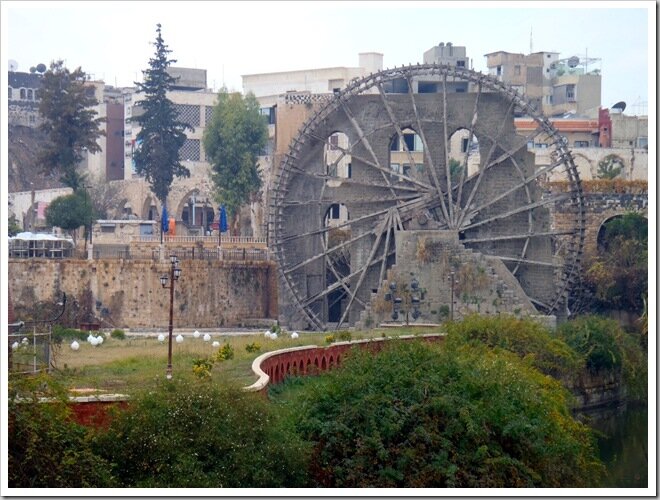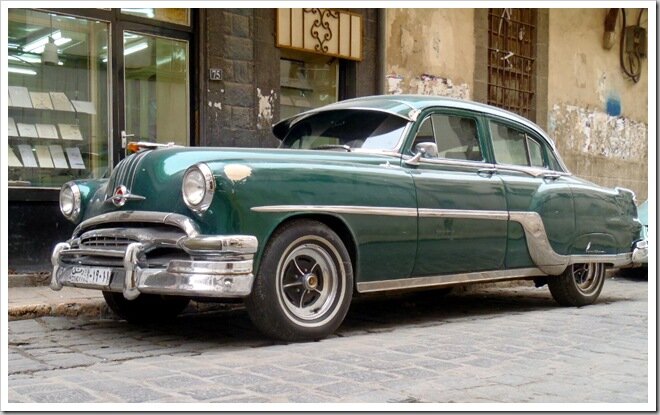The road from the border to Aleppo was clearly signed, but once within the blender of thick traffic, roundabouts and one-way boulevards I found myself once again lost in a large city with sunset quickly approaching. My routine is to follow the main flow of traffic to the city center, locate a landmark to get my bearings, and then navigate to the part of town where cheap hotels abound. I was reading my map under a streetlamp when two young clean cut Syrians smiled and approached me saying, “Welcome”. They asked if I needed help, and when I told them I was looking for a hotel, they gladly started to give me directions. I nodded but I think they could see that I wasn’t really getting it, and they decided it would be best if they walked with me (while I rode the bike) a few blocks to make sure I didn’t get lost. While they walked and I idled along we chatted, and I learned that they were students at Al-Jdeida university, studying medicine and law. We reached a junction where the directions became less confusing, and they sent me on my way after taking a cell phone snapshot, saying “Welcome to Syria!”. I found a hotel and was a bit nervous about parking on the busy street, but the doorman said that he would have eyes on the bike all night. I reached into my pocket for some baksheesh money, only to realize that I had no Syrian pounds. I asked the doorman where I could find an ATM, and instead of giving directions he said, “Follow me” and we set off into the busy city night. (Hey, I thought you were going to watch my bike…?) The first ATM declined my money request, but the second one yielded paper fruit. I paid the doorman a small fee for giving my bike extra attention, had dinner in the hotel’s restaurant and flopped out in front of satellite TV.
My first order of business in Aleppo was to visit the citadel. The massive, sprawling complex is constructed on a man-made earthen mound, and although the first fortifications were built here by the Seleucids in the 3rd century BC, the main construction dates from the 12th Century crusades. Here is a beautiful photo that accurately portrays this imposing structure. Near the entrance gate, I sat at a cafe and sipped tea while I pondered my attack.
With a small but dedicated army of Syrian pounds in pocket, I made my assault. Once inside, there were plenty of buildings and ruins to pick through, including an amphitheater.
The view of Aleppo from the battlements was excellent.
Note the earthmoving equipment in the moat. Back at the fortified gate, the top floor is occupied by the empty but beautifully restored throne room.
I spent the rest of the afternoon wandering the covered souk, parts of which date to the 13th century. This was the original shopping mall, with everything under one roof: souvenir scarves and keffiyehs, jewelry, spices, freshly butchered meat, fresh sweets, plumbing supplies, breadmaking supplies, sunglasses, electrical connectors, rope, tools, padlocks, shoes, and ladies underwear.
Some shopkeepers saw my western face and wished me a Merry Christmas! I didn’t escape without buying a few souvenirs for the folks back home.
From Aleppo I headed east to visit the ruins of Rasafa, and about halfway there something I ate in Aleppo decided to revolt. I could feel the sweat pouring out of my scalp and body, and I started desperately searching for the next roadside bathroom. One appeared just in time, and I paid no mind to the fact that the simple concrete structure contained only a hole for squatting, and a faucet with a small bucket of water. (Your author faithfully carries a roll of TP for such occasions, but there was no time to grab it, such was the urgency of the situation! Besides, there was no bin to dispose of used toilet tissue.) Relieved but still feeling queasy, I followed then crossed the wide and lazy Euphrates, and rolled into the city of Al Raqqa, checking in to the first hotel I could find, and promptly dozed until nightfall. When I woke up, my stomach was a tight knot, but I walked to a nearby mini market for a bottle of water. The shopkeeper invited me behind the counter for a glass of tea, and I spent an hour there talking with him about his travels to Africa and Europe as an artist and photographer. He showed me his dusty and trusty Canon AE-1 film camera, and a small folder of photos of his family, travels and some of his paintings and sketches. On a small television he found a channel showing a Hollywood teenage slasher flick in subtitled English, and eventually we were joined by a young neighborhood kid who’d stopped in to buy soap. When the youngster learned that I was American, I noticed that he started watching me very closely no matter what I did, not in a sinister way but with utmost curiosity. When I left I thanked the shop owner in Arabic, but he must have been Iraqi or Iranian, because he smiled and said, “Ah, we do not say ‘shukran’ here”. He said I should come back in the morning for more tea and conversation. The young fellow thought hard for a moment, then his face lit up and he smiled and said, “Tuesday!” Someone had been paying attention in English class!
The next morning I visited the ruins at Rasafa, and due to still feeling unwell spent only a few minutes exploring and took few photos. From Rasafa I headed south then west toward Palmyra, easily found the Ishtar hotel (in the upper end of the lower budget range) and checked in for two nights. Palmyra (known in Arabic as Tadmor) is mentioned in texts dating as far back as the 2nd millennium, BC, but grew to prominence as a Silk Road stop under the Romans in the 1st and 2nd centuries AD. In the 3rd century, Queen Zenobia rose to power against the wishes of Rome, and after defeating the army that had been dispatched to deal with her, she went on to defeat the Roman garrison at the capital of Arabia (Bosra), and successfully invaded Egypt. Rome eventually laid siege to Palmyra, capturing the rebel queen as she fled on camelback to seek military assistance from Persia. The following year, more rebellion caused a decisive and overwhelming response from Rome, from which Palmyra never recovered.
Below, the Great Collonade runs the length of the ruins.
The theater, where someone mis-timed a self-portrait.
Column details at the temple of Bel.
More artistic goodness at Bel’s temple.
Heading west from Palmyra, I stopped for a bite at the Bagdad Cafe…
…and eventually made my way to Hama, where 13th century wooden norias (water wheels) deliver water to aqueducts.
Unfortunately the Orontes river wasn’t flowing and the wheels were stationary, otherwise (it is reported) the wooden axles and blocks make a mournful groaning. After a night in Hama, I headed south and west to visit Crac de Chevalier, considered by many (including T.E. Lawrence) to be the finest example of a crusader castle in existence. The crac is reached through a series of steep hairpin turns from the town of Hosn.
Original fortification were built here in 1031, but it was 12th century crusaders that expanded and fortified the castle into its present form. Looming over the only break in the Jebel Ansariyya, the castle was never defeated; the last defending crusaders simply gave up during a protracted siege in the last days of crusader presence in the Middle East.
Below, the view from the command tower.
Myself, I retreated to the nearby Al Qalaa restaurant for sustenance, dining with two busloads of Italian tourists. Roasted chicken, raw veggies, fried potatoes, several kinds of dips and flatbread, along with a crisp Lebanese beer to wash it down. Food and service were both excellent.
I surprised myself by entering Damascus with plenty of daylight to spare, and even further by finding the very hotel I was looking for, near a parking garage. (One of the few stories I’d heard of an overlander’s motorcycle being stolen was in Damascus, so secure parking was something I was set on finding.) My hotel was a short walk from the walled Old City, and immediately upon entering found myself in the covered Souq Al-Hamidiyya.
The holes in the souq’s corrugated metal roof are from machine gun fire during the 1925 nationalist rebellion against France. Passageways branching from the main thoroughfare specialized in various items for sale: hardware and building supplies, cooking and kitchen gadgets, clothes, jewelry, bolts of silk and other fine (and not so fine) cloth, spices, meat, sweets, and so on.
If the above were a scratch-and-sniff photo, you’d book your flight (or prep your bike) tomorrow!
The fellows below were hammering out knife blades.
Popping out of the souk, I found myself under the corinthian columns of the Western Temple Gate, a 3rd century temple of Jupiter.
This led directly to the Umayyad Mosque, one of the most holy mosques in all of Islam. Crowds of pilgrims and a few western tourists milled about until the doors opened at mid-morning. Shoes were removed before stepping into the polished courtyard. (Note: If you visit, wait an hour or so after opening time before entering, or you’ll have soaked socks from the recently washed courtyard.)
Inside the prayer hall, pilgrims were seated on the floor in small groups, separated into men and women, clustered around men speaking in low tones.
I was drawn to one group when I heard what I thought was muffled laughter. A compact man sporting a neatly trimmed beard, dressed in a brown Western suit (sans tie), was speaking to the seated pilgrims in soft but direct tones, punctuating his speech with small hand gestures. On the men’s side of the group was a half dozen elderly men, dressed in white, who rather than laughing were sobbing softly into handkerchiefs. The rest of the gathered were listening quietly, not taking their eyes off the speaker. I wanted badly to understand what he was saying, to know what would move the old men to tears. The speaker’s voice never rose above a conversational tone, his hands never pointed at the listeners, or the sky or the ground; it sounded as if he were patiently explaining a set of very simple facts. The entire prayer hall was milling with people, but it was permeated by a quiet reverence that prevented it from becoming raucous or overwhelming.
Back outside, I wandered the narrow streets until I entered the Christian quarter, where there were more women shopkeepers and the souvenir shops sold plaques that read “God Bless Our Home”. I also spied this vintage Pontiac.
The interior was in great shape too! The old streets became quite narrow, but this didn’t prevent cars and goods delivery vehicles from squeezing through, often rubbing their mirrors on storefront display stands.
While exiting Syria, I met a young Spanish fellow on a KTM 640 coming the other way.
I envied the fact that he was traveling even lighter than I was., but in the hustle of the border process we didn’t get a chance to talk at length about bikes or travel (mis)adventures. I was curious about the custom tanks that were mounted to his skid plate. When I asked about Jordan, he summed it up succinctly: “Super-friendly, but expensive!”



























